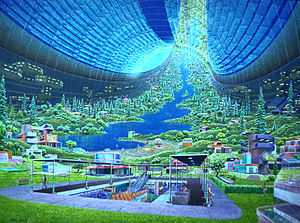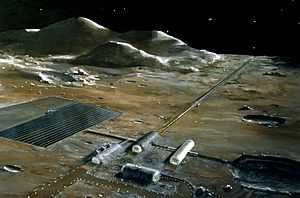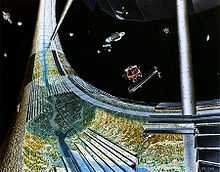Stanford torus


The Stanford torus is a proposed design[1] for a space habitat capable of housing 10,000 to 140,000 permanent residents.[2]
The Stanford torus was proposed during the 1975 NASA Summer Study, conducted at Stanford University, with the purpose of speculating on designs for future space colonies[3] (Gerard O'Neill later proposed his Island One or Bernal sphere as an alternative to the torus[4]). "Stanford torus" refers only to this particular version of the design, as the concept of a ring-shaped rotating space station was previously proposed by Wernher von Braun[5] and Herman Potočnik.[6]
It consists of a torus, or doughnut-shaped ring, that is 1.8 km in diameter (for the proposed 10,000 person habitat described in the 1975 Summer Study) and rotates once per minute to provide between 0.9g and 1.0g of artificial gravity on the inside of the outer ring via centrifugal force.[7]
Sunlight is provided to the interior of the torus by a system of mirrors. The ring is connected to a hub via a number of "spokes", which serve as conduits for people and materials travelling to and from the hub. Since the hub is at the rotational axis of the station, it experiences the least artificial gravity and is the easiest location for spacecraft to dock. Zero-gravity industry is performed in a non-rotating module attached to the hub's axis.[8]
The interior space of the torus itself is used as living space, and is large enough that a "natural" environment can be simulated; the torus appears similar to a long, narrow, straight glacial valley whose ends curve upward and eventually meet overhead to form a complete circle. The population density is similar to a dense suburb, with part of the ring dedicated to agriculture and part to housing.[9]
Construction
The torus would require nearly 10 million tons of mass. Construction would use materials extracted from the Moon and sent to space using a mass driver. A mass catcher at L2 would collect the materials, transporting them to L5 where they could be processed in an industrial facility to construct the torus. Only materials that could not be obtained from the Moon would have to be imported from Earth. Asteroid mining was an alternative source of materials.[10]
General characteristics
- Location: Earth–Moon L5 Lagrangian point
- Total mass: 10 million tons (including radiation shield (95%), habitat, and atmosphere)
- Diameter: 1,790 m (1.11 mi)
- Habitation tube diameter: 130 m (430 ft)
- Spokes: 6 spokes of 15 m (49 ft) diameter
- Rotation: 1 revolution per minute
- Radiation shield: 1.7 meters (5.6 feet) thick raw lunar soil
Gallery
-

Stanford torus configuration.
-

Stanford torus structural cross section.
-

Transportation system for the torus construction (1975).
-

A torus expanding from interconnected bolas or dumbbells.
-

A NASA lunar base concept with a mass driver (the long structure that extends toward the horizon).
-

External view of a Stanford torus with some of the radiation-shielding "chevron" mirrors removed to show interior space
-

Cutaway view of a Stanford torus.
In fiction
- One of the earliest portrayals of a similar station is shown in 1957 Soviet popular science film Road to the Stars by Pavel Klushantsev.
- John Varley's Gaea trilogy is about a Stanford torus in orbit around Saturn.
- The colonies in Mobile Suit Gundam Wing are Stanford tori (the colonies in the original Mobile Suit Gundam are O'Neill cylinders).
- There have been many other wheel-shaped space habitats in science fiction, such as Larry Niven's Ringworld or the Earth-orbiting Space Station V invented by Arthur C. Clarke and Stanley Kubrick and depicted in Kubrick's 1968 movie 2001: A Space Odyssey.
- The computer video game Startopia provides a real-time simulation of a Stanford torus.
- The eponymous space station of Elysium is reminiscent of but much larger than a Stanford torus. The inner wall of the station (the "ceiling") is missing, which means ships can land directly inside the colony at any point, with the atmosphere being kept in place presumably by centripetal force. In reality this would not be enough to maintain suitable air pressure and the atmosphere would leak out into space.
- The Presidium level of the Citadel in the game Mass Effect is a Stanford torus design, greatly resembling the Donald E. Davis painting above.
- Iain M. Banks' Culture novels tell of Stanford torus shaped worlds of enormous scale. Designed, created and inhabited by the Culture and their Minds as they explore and enjoy their galaxies.
See also
- Asteroid mining
- Colonization of the Moon
- Rotating wheel space station
- Bernal sphere
- O'Neill cylinder
- Space colonization
- Space stations and habitats in fiction#Toroidal or annular habitats
References
- ↑ Johnson, Holbrow (1977). "Space Settlements: A Design Study". National Aeronautics and Space Administration.
- ↑ Johnson. NASA Study, pg 1, "The Overall System", pg 60, Summary
- ↑ Johnson. NASA Study, pg VII, "Preface"
- ↑ Gerard K. O'Neil, "The High Frontier", William Morrow & Co., 1977, p149
- ↑ Von Braun, W.:Crossing the Final Frontier, Colliers, March 22, 1952
- ↑ Hermann Potočnik: The Problem of Space Travel (1929)
- ↑ Johnson, NASA study, p46
- ↑ Johnson. NASA Study, Chap. 5
- ↑ Johnson. NASA Study, Chap. 5
- ↑ Johnson, Richard D.; Holbrow, Charles (1977). "Space Settlements: A Design Study". NASA Technical Reports Server. p. 201. Retrieved October 20, 2012.
External links
| Wikimedia Commons has media related to Stanford Torus. |
- Video about stanford torus from NASA Ames around 1980 on YouTube (5 min)
- Visualisation of stanford torus construction from an asteroid mining facility in 2010
- Another visualization of a Stanford Torus
| ||||||||||||||||||||||||||||||||||||||||||||||||||